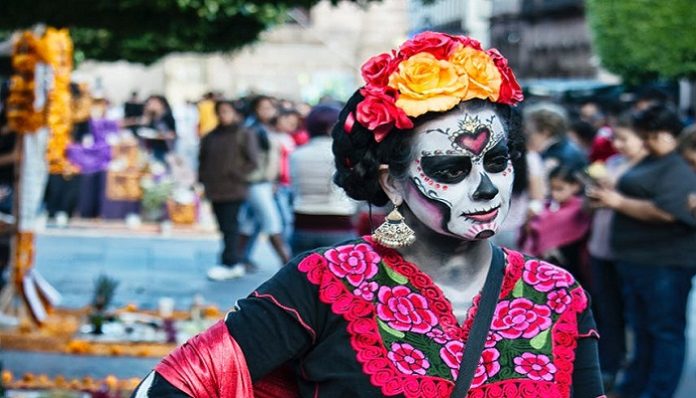
I don’t know why it’s so appealing – maybe the colors and flowers, or the way sugar skulls are both beautiful and scary. But Americans really love Day of the Dead. This Halloween I counted dozens of painted ladies dressed as gorgeous and gruesome skeletons in celebration of the tradition. Yet, most times Americans hold pretty inaccurate ideas of what the holiday and its imagery really means.
I am not Mexican-American, and I cannot explain the importance of this holiday in my own life. I have been blessed to work in Mexican immigrant communities for the past three years – with men and women who have welcomed me into their homes for Day of the Dead celebrations and who took the time to teach me about the holiday. So, I can only explain to you what other have taught me and point you in the direction of some great resources.
First of all, Day of the Dead is not Mexican Halloween. The holiday is celebrated on November 1 and 2, typically seen as All Saints and All Souls Day for Christians in the United States. The day is much more like these holidays than today’s Halloween traditions, as it celebrates death and all of those who have died in a really joyous and colorful way. Altars are built and decorated in celebration of departed loved ones, filled with special foods and offerings. Though Halloween was originally meant to celebrate our deceased loved ones in this way, it’s much more about spooky things, candy and costumes today.
One important decoration for these are sugar skulls and skeletons, known as calaveras. The Mexic-Arte Museum in Austin reports that the tradition of using these images dates back to the early twentieth century with artist Jose Guadalupe Posada.
Though skeletons and death are scary, Day of the Dead is not a sad day! Celebrants believe that the spirits of those who have died are able to visit on these days, and building altars and sitting in cemeteries aren’t second funerals. They’re genuine parties! Watch Eddie G’s guide to Day of the Dead for some direct insight.
https://www.youtube.com/watch?v=jJ5Qo4CubxI
After Mexico won its independence from Spain, the country’s government pushed to celebrate Day of the Dead – to establish a uniquely Mexican holiday that could form its own cultural identity. Though the practice did bring the country and its people together, there are still practices that are unique to each region of Mexico. So, if you come across a Day of the Dead celebration, you’ll probably find altars from Puebla, Jalisco and other popular towns – each with its own style and unique features.
So much vibrancy, diversity and importance placed on this holiday makes it really sad to see the ways its imagery is appropriated for trendy Halloween costumes. The blog This Is Not Our Día de Los Muertos calls out such theft of this sacred holiday, including many popular make-up tutorials in Elle and other beauty magazines. Curators will reblog photos and videos – often from private Tumblr blogs – and put them on blast for all of their audience to see.
While the blog’s method may be a little in-your-face, they have a point: Why do we all think it’s okay to paint our faces like this on Halloween?
However, rather than placing shame or guilt on anyone for current or past Halloween costumes, I hope you yourself can see the rich history of this holiday. You don’t mean to offend Mexican and Mexican-American culture if you don’t know any better, but this Halloween let’s inform ourselves and our friends about Day of the Dead and think twice before we dress up this weekend!
Featured image via Genaro Servín on Pexels


















